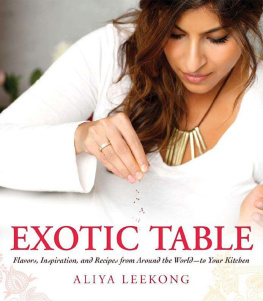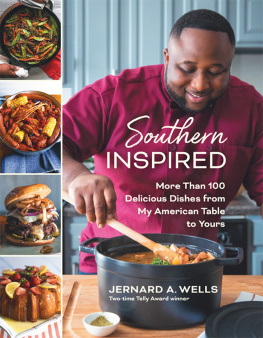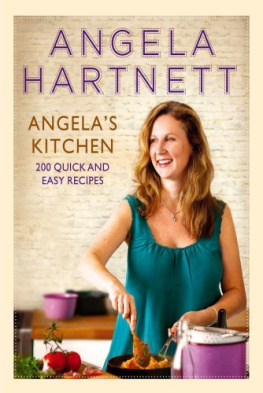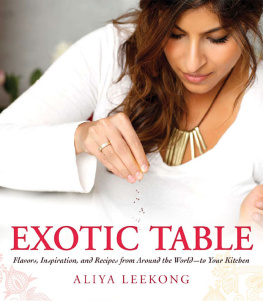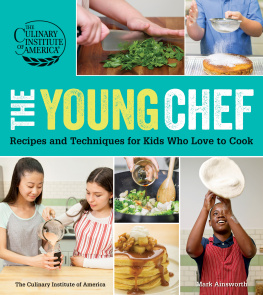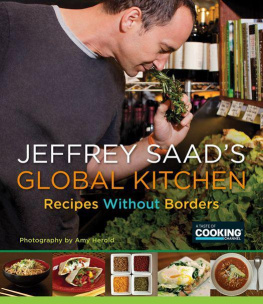EXOTIC TABLE
Flavors, Inspiration, and Recipes from Around the Worldto Your Kitchen
ALIYA LEEKONG

AVON, MASSACHUSETTS
Brighter than fireflies upon the Uji River
Are your words in the dark, Beloved.
AMY LOWELL
To the love of my life, Aren LeeKong.
CONTENTS
INTRODUCTION
Over the years, Ive noticed that when you talk to people about food, its never really about the food. Sure, it starts that way. You discuss what someone likes to cook, ingredients that resonate, dishes their family loves, but then it almost always becomes a conversation about how they grew up, their childhood food memories, history, and strong life influences.
I, like many others, learned at my mothers and other family members hips in the kitchen. My heritage is multiculturalIndo-Pakistani and Tanzanianand I remember how both the cuisines and mother tongues of my parents blended as a child, to the extent that I was never quite sure to which side a particular dish or word belonged. This blend was completely natural, a personal mashup, and certainly has spilled over into my way of thinking about life and food.
The idea of making food based on your personal history is found in countries all over the world. After all, a country or regions cuisine is a direct reflection of its historywar, invasion, immigration of peoples. Each additional culture contributes bits and pieces along the way. For example, Peruvian culture is inclusive of the indigenous Native Americans, conquering Spanish (some with Arabic wives), and Japanese and Chinese immigrants. South Africa has Dutch, Malay, Indian, Arab, Portuguese, German, and the indigenous African tribes like Khoikhoi, Xhosa, and Zulu. Turkeys cuisine came from the Mongols, Chinese, Persians, European Mediterraneans, and other Arabic and Slavic influences. And I might even be missing some influences in these lists.
America is no different, and has certainly become one of the most open cultures, attempting to embrace diversity. Immigrants come from all over the world; families move and migrate and marry. Im now married to a guy from Brooklyn, whose family comes from Trinidad by way of Venezuela, Spain, and China. What I cook at home is a complete amalgamation of both of our cultures histories. Though many dishes are based in the past, I sometimes imagine our future children and the blend that they will grow up understanding as their own.
Many of us start off with culture thats passed on from our family, and then we build on it by absorbing aspects from our own life. Thats what I like to call a persons cultural layers: family, education, marriage, travels, influences of friends and colleagues, likes, and dislikes. All of these factors play into the way a person cooks.
We are incredibly fortunate to live in a time when different ingredients and spices are readily accessible, and when other cultures foods have comingled and entered the American dialogue. What might have been called exotic just ten years ago might not be so today.
I cook, quite simply, the way that I eat. My style is not about elevation or modernism; its just my personal way of preserving food traditions. I am not a purist, and my travels, heritage, family, or even culinary training, serve merely as inspirationI do not declare that anything I cook is exactly per the tradition. I work with what I can find, have on hand, or simply prefer flavorwise. I encourage you to follow the same idea as you read through my stories and try the recipes in this book.
Look for recipes where traditions, spices, or ingredients from other cultures make that easy transition into your own, when they become something translatable, taking foods you know and love to another level. For example, you could simply incorporate a new spice or blend into a recipe you have lying around, or you could try a technique you learned from another culture on an ingredient your family already likes.
Just like you, I go to the grocery store. I entertain for friends and family. I have busy weeknights. I have friends who are vegan, and some who are eating gluten-free. All of that is reflected in this book. (Look for the labels to show you which recipes are vegetarian, vegan, or gluten-free. In addition, consider that some recipes can be made vegetarian or vegan simply by swapping vegetable stock for chicken stock, for example.)
I take the idea of exotic, which is to say globally influenced through my personal lens, and bring it into my everyday cooking. I honor my American sensibilities and simultaneously pay homage to the flavors and traditions of a variety of ethnicitiesthis is my Exotic Table. I make things easier or simpler where its efficient, but Im also not afraid of the old-school: long braises, sauces from scratch, and a complex layering of flavors.
Food is subject to interpretation, to personal reinvention, and my goal is not to give you a set way of doing things. Im a teach-a-woman-to-fish kind of gal, and food is ultimately about identity, a language containing your own heritage and traditions. Take my ideas and see how they work with your own cultural layers. Play, experiment, make them yours, and see what blend you come up with.
Chapter 1
SPICES, INGREDIENTS, AND EQUIPMENT

This next section is dedicated to what I like to call my Exotic Pantrysome of my favorite spice blends and condiments that I keep in my kitchen at all times. These are building blockstruly easy ways to start creating your own layers of flavor.
Having these items at the ready means one less step and, for me, a more seamless and enjoyable cooking process. Its easy to jazz up everyday cooking when you have a little Ras El Hanout, a fragrant North African spice blend, or Sambal Oelek, a good, basic chili paste, around. Youll see that many of the recipes from other chapters of the book pull from this section, but my hope is that you come up with your own uses for them too.
Spices
Spices, to me, form a cuisines signaturethat aromatic blend that provides instant information as to a dishs origins. I keep my pantry stocked and go through a decent quantity of spices on a regular basis. As you decide which flavors you like best, you can do the same thing.
Keeping Spices Fresh
Here are a few keys to maintaining their intense flavor:
- Keep spices in airtight containers in a cool, dark spot away from humidity. Light, heat, and moisture all degrade the flavor. Ground spices stay fresh for 6 months, and whole spices up to a year.
- You can keep chili flakes in airtight containers at room temperature if they are of the drier sort. If the chili flakes are oily, like an Aleppo or Urfa chili, store them in the freezer. This helps their flavors stay bright and fruity, and they will keep for up to a year.
- Whole spices keep their flavor more intensely and for a longer period of time than ground spices because they have less surface area for the aroma and flavor to dissipate from. Try to grind spices in small quantities as you need themI do this regularly with items like black pepper, cumin seeds, and cinnamon.
- Toasting spices can bring them back from the dead. If you taste a ground spice and theres no spark, try toasting it in a dry skillet over a medium-low flame to see if that revives the flavor.
- If you must keep a spice in ground form, try to keep it in a smaller quantity and buy it more often to make sure its as fresh as possible.

